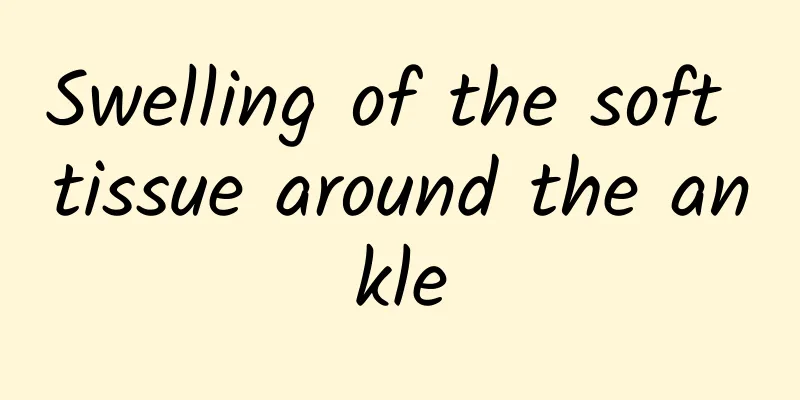Swelling of the soft tissue around the ankle

|
The ankle joint is a joint that is more prone to injury. Due to long-term walking, the ligaments and tissues around the ankle joint will be damaged, resulting in ligament stretching or tearing. When an ankle is sprained, the surrounding soft tissue will swell. If not treated properly, sequelae of habitual sprain will occur. This article introduces the causes of ankle sprains and subsequent rehabilitation plans. Let’s take a look. We often suffer ankle injuries in our daily life and sports, commonly known as sprains. Studies have shown that ankle injuries are the most common sports injuries, accounting for 20-40% of all sports injuries. Ankle injuries are mostly caused by excessive stretching or tearing of the ligaments around the ankle joint, and in severe cases may be accompanied by avulsion fractures. The ankle joint is an important movement and weight-bearing joint in the human body. It is the main weight-bearing joint that comes into contact with the ground first during exercise. Therefore, the function of the ankle joint directly affects people's movement function and quality of life. So why is the ankle joint prone to injury? How to prevent ankle injuries? What are the treatment and rehabilitation principles after ankle injuries? The ankle joint is composed of the fibula, tibia and talus, and the ligaments around the ankle joint (including the medial ligament, lateral ligament, inferior tibiofibular ligament, etc.). The ligaments around the ankle joint play a vital role in maintaining the stability of the ankle joint. The anatomical characteristics of the ankle joint are: the lateral ligament is relatively weak, the lateral malleolus is longer than the medial malleolus, the talus is wider in front and narrower in the back, and the narrowest part of the talus is located in the ankle cavity when the ankle joint is plantar flexed, which reduces the bony stability, and the muscle strength controlling the inversion of the ankle joint is greater than the eversion muscle strength. The above anatomical and physiological factors determine that the ankle joint is prone to sprains in the plantar flexion and inversion position, and therefore damage to the lateral ligament is most common. Statistics show that lateral ankle injuries account for 85% of all ankle injuries. Immediately after a sprain, the patient experiences pain at the sprained site, followed by swelling and skin bruising. In severe cases, the affected foot cannot move due to pain and swelling. When the ankle joint is injured, the soft tissues inside the joint are squeezed and impacted, causing cartilage surface damage, synovial swelling, and surrounding ligament tearing, resulting in swelling and congestion around the ankle joint. If correct treatment and rehabilitation are not carried out in time after an ankle injury, the strength of the ankle ligaments will decrease, resulting in a decrease in the ankle's stability function and a decrease in the ankle's proprioception. The existence of an unstable ankle joint makes it easy for the ankle joint to be injured again, or to develop chronic injury symptoms such as movement pain and swelling. It can also cause an imbalance in the body's movement posture and chronic injuries to other joints, leading to a series of other chain injuries. How to prevent ankle sports injuries: Preventive measures include exercises for lower extremity flexibility, balance, proprioception, and muscle strength to enhance stability and agility. 1) Lower limb flexibility training includes: static stretching and sufficient warm-up exercises before exercise. 2) Balance ability and proprioception training include: standing on one foot with eyes closed and training on a balance mat. 3) Muscle strength training includes: double-foot heel raise training and single-foot heel raise training. 4) Choose soft-soled high-top sports shoes and wear protective gear when exercising. Ankle Injury Treatment and Rehabilitation: First of all, the principle of early treatment of acute ankle sprain is RICE (rest; ice; compression; elevation). This principle must be strictly followed in the early stages of injury. At the same time, you should go to a regular specialist hospital for treatment and take X-rays to rule out ankle fractures. A specialist can make a correct diagnosis and provide appropriate treatment based on the medical history and physical examination. In the early stage of injury, use a brace or protective gear for relative immobilization and protection within 3 weeks, and try to avoid weight bearing. You can actively move your toes and perform isometric contractions of your calf muscles in a non-weight-bearing environment to promote swelling reduction. After the acute phase, under the guidance of a doctor or rehabilitation therapist, you can gradually start active full-range motion exercises and weight-bearing, exercise your proprioception on an inclined board, strengthen your peroneal muscles, so as to enhance the stability of the ankle joint and avoid future sprains caused by residual ankle instability. At the same time, we would like to remind everyone that after each rehabilitation treatment, the ankle joint needs to be iced. Remember that hot compresses are not allowed on the injured ankle joint during rehabilitation and treatment. There is some controversy regarding the treatment of severe injuries, and nonsurgical approaches are still recommended. Although some experts emphasize that primary repair of torn ligaments can achieve better results, a large number of comparative studies on the effects of surgery and conservative treatment have shown that surgical treatment is no better than conservative treatment. Finally, I need to remind everyone that many people mistakenly believe that ankle injuries, if not fractures, can be healed by "resting for a few days." In fact, this is not the case. Studies have found that patients who have not received regular treatment are 3-4 times more likely to suffer another ankle injury than those who have received regular treatment. |
Recommend
Baby's fingers are bent
Pregnant women are a relatively special group, an...
What are the symptoms of endocrine disorders?
For women, endocrine disorders are a relatively c...
What are the symptoms of gastrointestinal inflammation?
We all know what kind of disease "getting an...
Small pimples next to the areola
As a woman's breasts develop, her areola also...
Classic Chinese medicine sachet recipe
Chinese herbal medicines have a wide range of the...
What are the treatments for hypernatremia and hyperchloremia?
Hypernatremia and hyperchloremia must be treated ...
Composition of Chushi Weiling Decoction
Ju Rui Wu Ling San can invigorate the spleen and ...
How to clean the vagina effectively?
Many female friends are prone to gynecological di...
Can Hepatitis B virus be transmitted to humans?
Hepatitis itself is a serious disease, and hepati...
Feeling of incomplete bowel movements
It is normal to have a bowel movement once a day....
Vulvar polyps
Polyps are growths that grow on the surface of hu...
Five common methods of promoting blood circulation and removing blood stasis are taught to you
Generally speaking, older people are more prone t...
How to treat vesicular tinea pedis and tinea manuum? Traditional Chinese medicine has folk prescriptions for treatment
Tinea pedis and tinea manuum are common fungal sk...
Treatment for small cell lung cancer
Small cell lung cancer is actually a common type ...
What medicine should I use for skin burns caused by electric welding?
If welders do not pay attention to the operating ...









